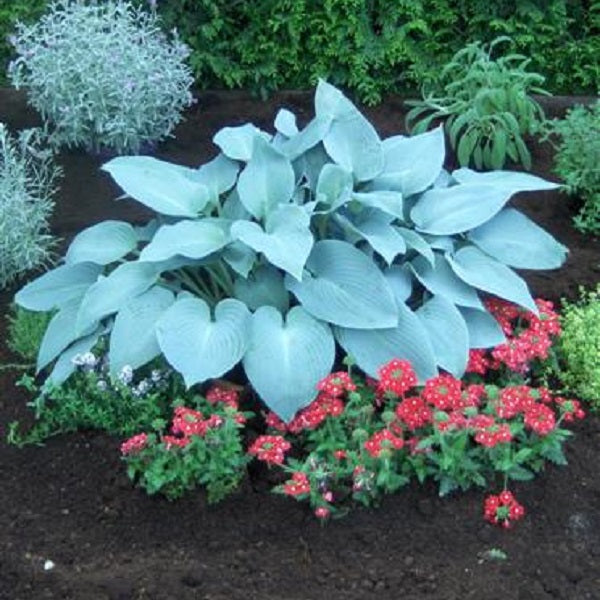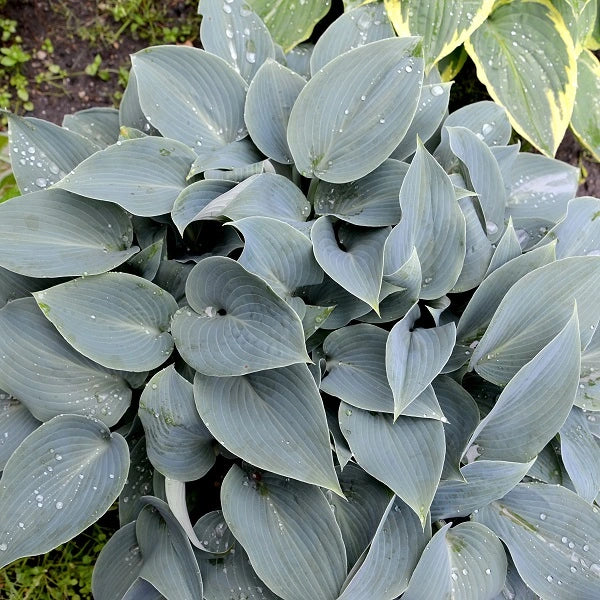Canadian Blue - Tall Hosta
Couldn't load pickup availability
Description
Hosta grow best in moist, well-drained, highly organic soils with a pH between 5.5 and 7.5. Sandy loam is better than clay because it provides more aeration for the roots. High-filtered or dappled sunlight is necessary for clean, healthy growth. Morning sun is tolerable and will help to intensify the leaf colors, but hot afternoon sun is usually deadly to Hosta. They are most at home in shady, woodland settings and often work well as specimen or edging plants.
Especially in northern zones, hostas should be mulched with a layer of finely shredded organic material to prevent heaving in the winter. Mulch is beneficial because it retains moisture around the plant's roots, but it is also the ideal place for slugs to hide. Watch for holes in the center of the leaves. If they are present, so are slugs. Applying a slug bait in early spring when new shoots are beginning to emerge will help to reduce the slug population. After a few years when plants are firmly established, the mulch can be removed completely, which should eliminate the slug problem altogether. Also be sure to clean all Hosta foliage out of the garden in early winter after the plants have gone dormant. By doing so, you will be ridding the area of the eggs of slugs and other leaf-eating insects.
Shipping Schedule
Shipping Schedule
We currently only ship to the 48 contiguous U.S. states. Shipments are scheduled by USDA Hardiness Zone, ensuring your plants arrive ready to thrive.
| Plant Type | Shipping Window |
|---|---|
| Daylilies | Early Mar – Early Nov |
| Lily Bulbs | Mid/Late Mar – Mid/Late May; Late Sep – Early Nov |
| Cannas & Dahlias | Early Mar – Mid-May |
| Daffodils | Early Mar – Mid-May |
| Perennials, Grasses & Hosta | Early Mar – Mid-May; Mid Sep – Early Nov |
| Iris | Early Mar – Early Jun; Mid Aug – Early Nov |
| Peonies | Early Mar – Mid-May; Early Sep – Early Nov |
| Tulips, Giant Allium & Magic Lilies | Early Oct – Early Nov |
Do you split orders?
We do not split orders by default. Place a separate order to receive “ready now” items sooner.
What is the shipping priority?
We ship to colder zones first, then proceed to warmer zones.
Do I need lead time before planting?
Most perennials need 4–6 weeks in-ground before the first freeze.
When do you start shipping to my zone?
| Zone | Approx. Shipping Time |
|---|---|
| Zones 7–11 | Early–Mid March |
| Zone 6 | Late March |
| Zone 5 | Mid April |
| Zone 4 | Late April |
| Zone 3 | Early May |
Find Your Growing Zone
The Wild & Son® Guarantee
The Wild & Son® Guarantee
At Wild & Son, we’re committed to ensuring your gardening experience is nothing short of exceptional. That’s why, if you’re dissatisfied with any plant, for any reason, simply let us know. We’ll issue a merchandise credit, no questions asked. It’s our promise to you, rooted in over 150 years of dedicated customer care.


-

Free Shipping Over $99
Enjoy complimentary shipping on all orders over $99 to the contiguous United States
-

The Wild & Son® Promise
If you're not 100% satisfied with your plant, it's on the house. No questions asked.
-

150 Years of Quality
We've been delivering the highest quality plants for over a century. From our farm to your door.
Recently viewed
What People Are Saying
- Choosing a selection results in a full page refresh.






